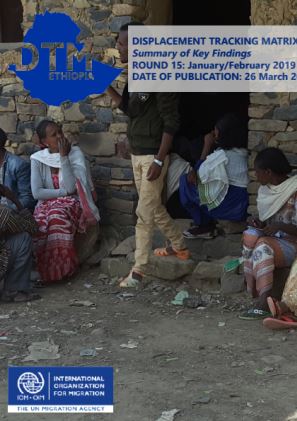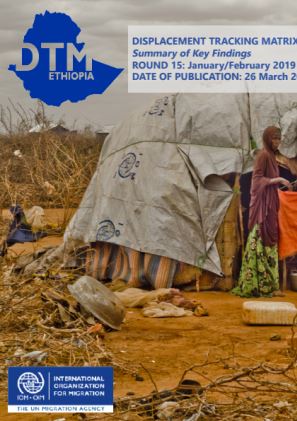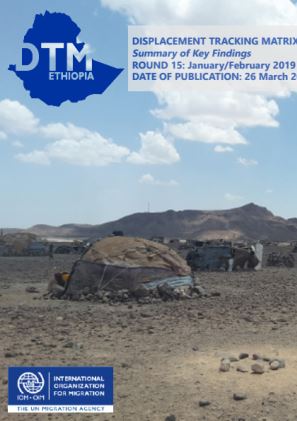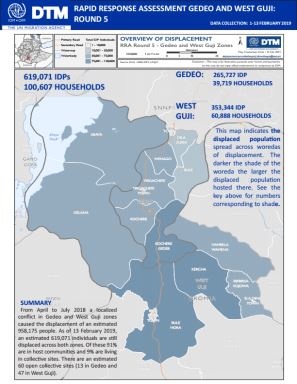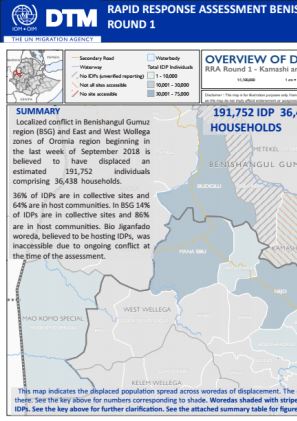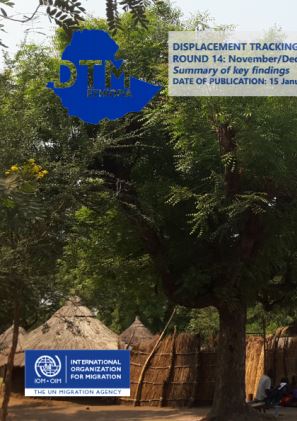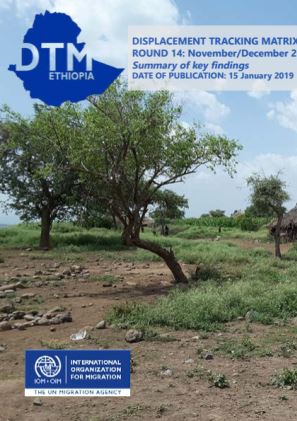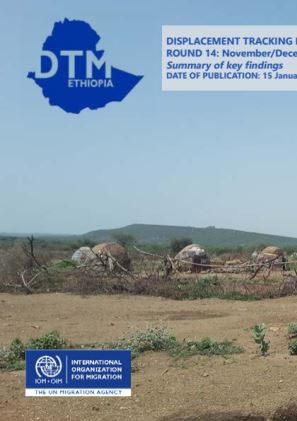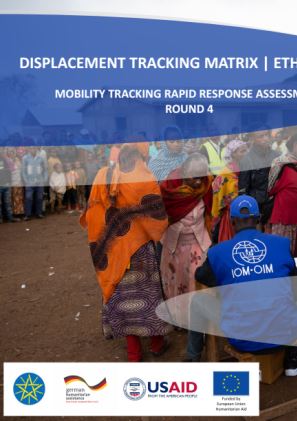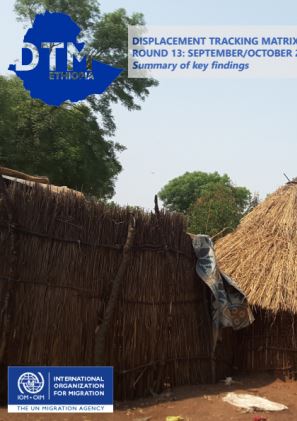-
Countries
-
Data and Analysis
-
Special Focus
-
Crisis Responses
Ethiopia
À propos Ethiopia
Ethiopia faces one of the most complex human mobility environments in the world, with a range of social, economic, political, and climatic factors driving populations within and outside its borders. .
The Data and Research Unit (DRU) at IOM Ethiopia, through its Displacement Tracking Matrix (DTM) methodology, gathers and analyzes data to disseminate critical multi layered information on the mobility, vulnerabilities, and needs of displaced and mobile populations that enables decision makers and responders to provide these populations with better context specific assistance. Since its launch in September 2016 in Ethiopia, the DTM has grown to be a fully integrated component of Ethiopia’s national and sub-national information management architecture, as it is the official source of data on internal displacement in the country. In Ethiopia, DRU implements the following three DTM components: Mobility Tracking (MT), Flow Monitoring (FM) and Surveys.
Mobility Tracking (MT) captures internal displacement and return through three annual rounds of Site Assessment (SA) (focused on IDPs, their multisectoral needs and the availability of services in their areas of displacement) and Village Assessment Survey (VAS) (focused on host community capacity to absorb returns targeting returning IDPs and their access to services with a focus on livelihoods and reintegration). MT data is largely used to inform humanitarian response and development planning and as such is coordinated with both humanitarian and development actors in country as well as with the Ethiopia Disaster Risk Management Commission.
Flow Monitoring (FM) captures inter-and intra-regional migration flows daily at key identified transit locations. This information is largely used to inform developmental programming including migrant assistance and protection programming. Through a route-based analysis, FM data has played a pivotal role in providing evidence base to respond to the Sudan crisis coordination.
Through the regular nationwide SA and VAS tools that fall under the MT component of the DTM methodology, the DRU builds and regularly updates a master-list of locations and information about how mobile population categories are geographically spread throughout the country. The baseline information contained in the master-lists allows for the construction of sampling frameworks and the selection of statistically representative samples. Using the sampling frameworks obtained through the nationwide regular assessments, DRU is able to plan and implement household level and individual Surveys to provide representative, granular information which can be triangulated with pre-existing DTM data, as well as external data sources. This data enables the humanitarian and development communities to obtain important insight into the needs, conditions, vulnerabilities, and intentions of mobile populations which can be particularly useful in informing programs, especially with regards to durable solutions, livelihoods, and other Humanitarian, Development and Peace Nexus (HDPN) related programming and policy initiatives.
DTM Ethiopia deploys over 200 staff and enumerators to track displacement, returns and mobile populations in the country.
More information on the methodology can be found under resources.
Current Donors
- Norway
- USAID
- DG ECHO
- DG INTPA
- European Commission
- MPTF
Ethiopia — Displacement Report 16, Amhara (March - April 2019)
90,144 displaced individuals comprising 21,439 households in 80 displacement sites were identified in Amhara region.
Ethiopia — Displacement Report 16, Afar (March - April 2019)
50,092 displaced individuals comprising 9,227 households in 58 displacement sites were identified in Afar region.
Ethiopia — East and West Wellega Rapid Response Assessment 2 (1 — 10 April 2019)
Localized conflict in Benishangul Gumuz region (BSG) and East and West Wollega zones of Oromia region beginning in the last week of September 2018 is believed to have displaced an estimated 191,995 individuals comprising 36,470 households.
Ethiopia — Gedeo and West Guji Rapid Response Assessment 6 (11 — 17 March 2019)
From April to July 2018 a localized conflict in Gedeo and West Guji zones caused the displacement of an estimated 958,175 people.
Ethiopia — National Displacement Dashboard 15 (January - February 2019)
The majority of the recorded population were displaced before 2018, with 904 sites which reportedly opened in 2016/17 (DTM Rounds 1 - 8). Conflict was reported as the primary driver of displacement (1,663,396 IDPs), followed by displacement due to climate induced factors (508,723 IDPs).
Ethiopia — Displacement Report 15, Tigray (January - February 2019)
82,968 displaced individuals comprising 38,293 households in 162 displacement sites were identified in Tigray region.
Ethiopia — Displacement Report 15, Somali (January - February 2019)
1,166,878 displaced individuals comprising 196,628 households in 409 displacement sites were identified in Somali region.
Ethiopia — Displacement Report 15, Oromia (January - February 2019)
859,290 displaced individuals comprising 143,902 households in 472 displacement sites were identified in Oromia region.
Ethiopia — Displacement Report 15, Gambella (January - February 2019)
20,741 displaced individuals comprising 3,064 households in 13 displacement sites were identified in Gambella region.
Ethiopia — Displacement Report 15, Amhara (January - February 2019)
There are 23,676 displaced individuals comprising 7,158 households in 74 displacement sites were identified in Amhara region.
Ethiopia — Displacement Report 15, Afar (January - February 2019)
49,437 displaced individuals comprising 8,980 households in 55 displacement sites were identified in Afar region.
Ethiopia — Gedeo and West Guji Rapid Response Assessment 5 (1-13 February 2019)
From April to July 2018 a localized conflict in Gedeo and West Guji zones caused the displacement of an estimated 958,175 people.
Ethiopia — Benishangul Gumuz/ East and West Wellega Rapid Response Assessment 1 (8 — 16 February 2019)
Localized conflict in Benishangul Gumuz region (BSG) and East and West Wollega zones of Oromia region beginning in the last week of September 2018 is believed to have displaced an estimated 191,752 individuals comprising 36,438 households.
Ethiopia — Interactive Site Profile Generator 14 (November - December 2018)
The interactive site profile generator can be used to create site profiles for any site assessed in the round. Simply select the site you wish to have a profile for and generate the new file.
Ethiopia — Displacement Report 14, Somali Region (November - December 2018)
1,006,276 displaced individuals comprising 167,652 households in 389 displacement sites were identified in Somali region.
Ethiopia — Displacement Report 14, Tigray Region (November - December 2018)
72,113 displaced individuals comprising 33,448 households in 149 displacement sites were identified in Tigray region.
Ethiopia — Displacement Report 14, Oromia Region (November - December 2018)
1,145,848 displaced individuals comprising 180,772 households in 515 displacement sites were identified in Oromia region.
Ethiopia — Displacement Report 14, Gambella Region (November - December 2018)
24,689 displaced individuals comprising 3,624 households in 14 displacement sites were identified in Gambella region.
Ethiopia — Displacement Report 14, Amhara Region (November - December 2018)
13,519 displaced individuals comprising 4,109 households in 59 displacement sites were identified in Amhara region.
Ethiopia — Displacement Report 14, Afar Region (November - December 2018)
50,619 displaced individuals comprising 8,780 households in 54 displacement sites were identified in Afar region.
Ethiopia — National Displacement Dashboard 14 (November/December 2018)
The majority of the recorded population were displaced during 2017 with 604 sites which reportedly opened in 2017 (DTM Rounds 3-8). Conflict was reported as the primary driver of displacement (1,773,482IDPs), followed by displacement due to climate induced factors (498,417IDPs).
Ethiopia — Gedeo and West Guji Rapid Response Assessment 4 (12-30 November2018)
From April to July 2018 a localized conflict in Gedeo and West Guji zones caused the displacement of 958,175 people. Of these, an estimated 166,792 individuals were displaced in West Guji while 791,383 individuals were reportedly displaced in Gedeo.
Ethiopia — Displacement Report 13, Oromia Region (September — October 2018)
907,525 displaced individuals comprising 143,901 households in 466 displacement sites were identified in Oromia region.
Ethiopia — Displacement Report 13, Gambella Region (September October 2018)
21,073 displaced individuals comprising 3,226 households in 14 displacement sites were identified in GAMBELLA region.







